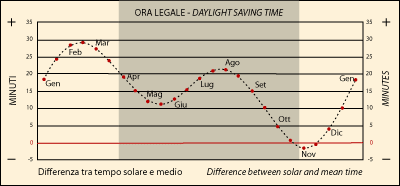|
Conceived as a "mathematical ornament" for the Institute and Museum of the History of Science, the sundial indicates true solar time for the place where it is located. The shadow cast by the glass globe atop the large bronze gnomon indicates the date and time. The hours from 9:00am to 2:00pm are marked out by radial brass lines while the date is indicated by the travertine traversal lines which signal the Sunís diurnal course for various periods of the year Ė precisely when the star enters the signs of the Zodiac.
The shadow cast by the gnomon changes in length during the course of the days and seasons, and indicates a different time than that of our wristwatches. In respect to true solar time, mean time indicated by our wristwatches has a periodic variation that during the course of a year can exceed a quarter of an hour. Moreover, when it is daylight saving time, during the spring and the summer, the hands of a clock are moved forward one hour. For example, true midday in the month of February would be indicated by the sundial around 12:28 pm while in the month of July it would be indicated around 13:20 pm daylight saving time.
How to use the sundial
To read the hour and the date it is sufficient to identify the hour lines and the calendrical or declination lines closest to the gnomonís shadow. When the shadow does not fall exactly on the hour line, one can read, with close approximation, the half hour and quarter hour, ideally subdividing in two or four parts the space between two hour lines. The date can also be read with good approximation by referring to the zodiac signs and the start of the months marked out along the meridian line.

How to read the sundial
The gnomon is formed from two large bronze stelae that symbolize the day and the night. The stele for the day, facing south, (towards the Arno river), contains a vertical meridian line in which the shadow from the tail of a Liziper (half lizard and half viper) indicate midday for each period of the year. The stele for the night, facing north, contains the representation of the two constellations that allow for the identification of the Polar star: the Ursa major and the Ursa minor. At the base of the gnomon is the wind rose that provides the directions for geographic orientation. Lastly, the seasons and the four elements are symbolized by the choice of materials: travertine for the earth and autumn; glass for the water and the winter; grey stone for the air and the spring; and bronze for the fire and summer.
Sundial Project Credits
Sponsors:
- Ente Cassa di Risparmio di Firenze
- City of Florence - Technical Services Department
- Florence Chamber of Commerce
- Institute and Museum of the History of Science (IMSS)
- Scuola Professionale Edile di Firenze ( SPE.F)
Istituto e Museo di Storia della Scienza
- Prof. Paolo Galluzzi - Director
- Arch. Filippo Camerota - Vicedirector
- Dr. Giorgio Strano - Curator of the Collections
- Arch. Teresa Saviori - Technical Coordination
City of Florence:
Technical Services Department
- Arch. Maurizio Barabesi - Director, P.O. Arredo and Immagine Urbana
- P.I. Matteo Redi - Planning Office
Scuola Professionale Edile di Firenze :
- Dr. Bruno Ferrari - Director, Scuola Professionale Edile di Firenze
- Geom. Angiolo Caselli - Technical Director, Scuola Professionale Edile di Firenze
- Eng. Carlos Agell - Institut Gaudì de la Construcciò - Barcelona
- Arch. Albert Pla - Escola Superior de Disseny Elisava - Barcelona
- Dr. Armand Labarre Fédération Compagnonnique des Métiers du Bâtiment - Limoges
- Prof. Albert Casals - Universitat Politecnica de Catalunya
- Prof. Carlo Alberto Garzonio - Director, Restoration and Conservation of Architectural Assets Department, University of Florence
- Prof. Maria Di Benedetto - Restoration and Conservation of Architectural Assets Department, University of Florence
Project:
- Concept and preliminary project: Arch. Filippo Camerota (IMSS)
- Design: Dr. Luise Schnabel
- Technical and Structural Details: Eng. Leonardo Paolini, Arch. Matteo Paolini
(SERTEC s.a.s)
- Hour Line Calculations and Ground Projections: Dr. Giorgio Strano (IMSS)
Development:
- Topographic Surveying and Graphical Restoration: Students of the surveying class of the SPE.F co-ordinated by Prof. Marco Bini - Architecture Department, University of Florence
- Development of Virtual Reality Simulations: IMSS Multimedia Laboratory
.................................
|